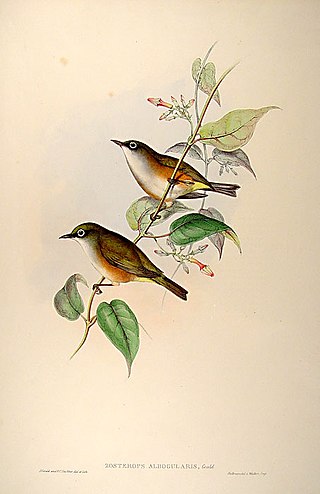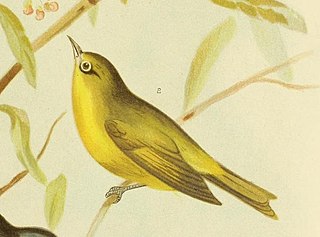
Zosterops is a genus of passerine birds containing the typical white-eyes in the white-eye family Zosteropidae. The genus has the largest number of species in the white-eye family. They occur in the Afrotropical, Indomalayan, and Australasian realms. Typical white-eyes have a length of between 8 and 15 cm. Their most characteristic feature is a conspicuous white feather ring around the eye, though some species lack it. The species in this group vary in the structural adaptations of the tongue. The Zosterops [griseotinctus] group is an example of a "great speciator" inhabiting a vast area and showing a remarkable morphological differentiation on islands, some of which may be as close as 2 km (1.2 mi) apart.

The Indian white-eye, formerly the Oriental white-eye, is a small species of passerine bird in the white-eye family. It is a resident breeder in open woodland on the Indian subcontinent. They forage in small groups, feeding on nectar and small insects. They are easily identified by the distinctive white eye-ring and overall yellowish upperparts. The range previously extended eastwards to Southeast Asia, Indonesia and Malaysia. Their name was recently changed due to previous members of Zosterops palpebrosus in Southeast Asia being renamed to a new species, making the Indian White-eye a more geographically accurate term for this species.

The Sri Lanka white-eye is a small passerine bird in the white-eye family, which is endemic to Sri Lanka. It is a resident breeder in forests, gardens and plantations, mainly in the highlands.

The warbling white-eye is a small passerine bird in the white-eye family. The specific epithet is occasionally written japonica, but this is incorrect due to the gender of the genus. Its native range includes much of East Asia, including the Russian Far East, Japan, Indonesia, Korea, and the Philippines. It has been intentionally introduced to other parts of the world as a pet and as pest control, with mixed results. As one of the native species of the Japanese islands, it has been depicted in Japanese art on numerous occasions, and historically was kept as a cage bird.

The white-chested white-eye also known as white-breasted white-eye or Norfolk white-eye was a passerine from the family Zosteropidae. It was endemic to Norfolk Island between New Caledonia and New Zealand and was regarded as either extremely rare or possibly extinct. Since 2000 the Australian government has considered the species extinct.

The Seychelles white-eye is a rare warbler-like perching bird from the family of white-eyes (Zosteropidae). It is endemic to the Seychelles. At one time thought to be extinct, it was rediscovered and is now listed as Vulnerable by the IUCN.
Sanford's white-eye is a species of bird in the family Zosteropidae. It is endemic to Nendo Island. It is named after Leonard Cutler Sanford, a trustee of the American Museum of Natural History.

The lemon-bellied white-eye is a species of bird in the family Zosteropidae. It is endemic to Indonesia, where it occurs on a number of islands from the Sunda Strait to the Aru Islands. It is present on several of the Lesser Sunda Islands as well as on parts of Sulawesi, as well as many smaller islands, but is absent from the larger islands of Borneo, Java, Sumatra and Timor. Currently, HBW describes five sub-species of lemon-bellied white-eye. However, the extensive distribution of Z. c. intermedius is likely to contain more than one reproductively isolated population (cf. Z.c. intermedius and Z. c. flavissimus, with the latter now considered a distinct species, the Wakatobi white-eye.

The pale-bellied white-eye is a species of bird in the family Zosteropidae. It is endemic to SE Sulawesi in Indonesia. Its natural habitat is subtropical or tropical moist lowland forest. The species has a limited distribution and also appears to be sensitive to human disturbance.

The bridled white-eye is a species of white-eye native to the Mariana Islands and formerly Guam. The species' natural habitat is tropical forests, shrublands and urban areas.

The canary white-eye or yellow white-eye is a species of white-eye endemic to northern Australia in subtropical or tropical mangrove forests. Its common name reflects the circle of white feathers around its eye.

The Christmas white-eye is a species of bird in the family Zosteropidae. It is endemic to Christmas Island. Its natural habitats are tropical and subtropical moist broadleaf forests and subtropical or tropical moist shrubland. It is threatened by habitat destruction.

The green-backed white-eye is a species of bird in the family Zosteropidae. It is also known as the New Caledonian white-eye. It is endemic to New Caledonia.
Wangi wangi or Wangi-wangi may refer to:
Wangi-wangi Island is in the north-west cluster of the Tukangbesi Islands and is the seat of the Wakatobi Regency, part of the province of Southeast Sulawesi. It covers an area of 191 km2 and had an estimated 61,283 inhabitants in mid 2022. To the west is the Gulf of Kolowana Watabo. The Wangi-wangi white-eye is a recently discovered endangered bird on the island.
The Seram white-eye is a small passerine bird in the white-eye family. It is an endemic resident breeder in open woodland in Seram, Indonesia.

The Togian white-eye is a species of bird in the family Zosteropidae.

The Wakatobi flowerpecker is a subspecies of the grey-sided flowerpecker that is endemic to the Wakatobi Islands of Indonesia. Some authorities consider it to be a separate species as Dicaeum kuehni.

The Wakatobi white-eye is a species of bird in the family Zosteropidae. It is endemic to Indonesia, where it is known only from the Wakatobi Islands off SE Sulawesi. It can be distinguished from most other Indonesian white-eyes by its bright yellow belly. It was formerly considered a subspecies of the lemon-bellied white-eye, but it was long known to be reproductively isolated from the rest of the species, and a 2019 genetic study found it to be a distinct species.

The Meratus white-eye is a species of bird in the white-eye family, Zosteropidae. The species was described in 2021 by the Indonesian ornithologist Mohammed Irham and his colleagues based on genetic, morphological, and vocal differences from other Zosterops white-eyes. It is endemic to the Meratus Mountains of Indonesian Borneo, where it has been observed on Mount Besar and Mount Karokangen. It inhabits the mid and lower storeys of closed-canopy montane forests at elevations between 1,300 and 1,650 m. It is a typical Zosterops white-eye, with deep olive-green upperparts, yellower underparts, a yellow stripe across the lores, and a distinctive bicoloured bill. Adults have a length of around 11–12 cm (4.3–4.7 in) and a mass of 8.5–9.5 g (0.30–0.34 oz). Both sexes look alike.
















